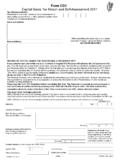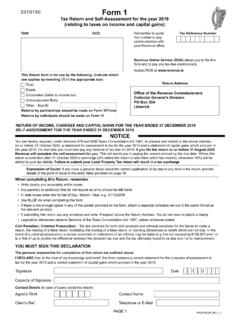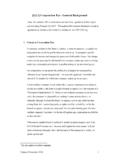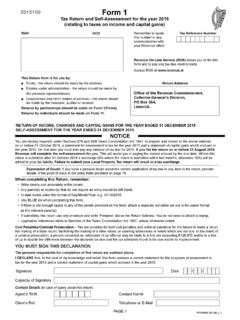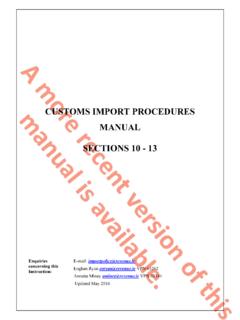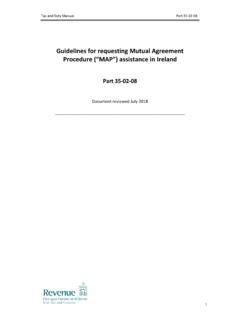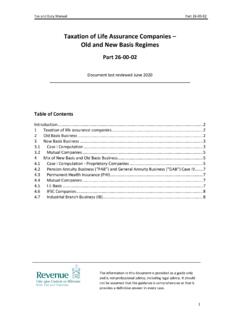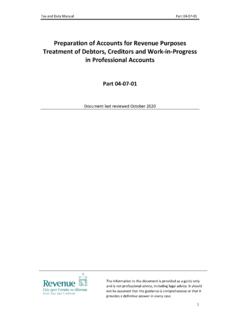Transcription of Part 04-00-01 - Guidelines on tax consequences of ...
1 Revenue Tax and Duty Manual part 04-00-011 Guidelines ON TAX consequences OF RECEIVERSHIP AND MORTGAGEE IN POSSESSION (MIP) part 04-00-01 Document last updated November Tax Tax Payment and Filing .1 Direct Taxes Irish Rental Direct Taxes Other Direct Taxes Capital Information to be provided upon Revenue sharing taxpayer information with a Capital Gains Tax Clearance Certificates (CG50As)..197. Reasonable Filing a Stamp Duty Return on ROS when property is being sold through a receiver/Mortgagee in Possession (MIP)..21 These Guidelines were prepared following consultation with the Receivership sub-committee of TALC, and the BPFI. Revenue would like to thank them for their Tax and Duty Manual part appointment of a receiver is one of the ways by which a lender can enforce a mortgage or charge.
2 There are various types of receivers. For example, there is a fixed charge receiver who is appointed under a mortgage in respect of a particular asset, an investment property. In contrast, a floating charge receiver is a receiver who takes control of a person s assets generally, or of certain categories of assets (for example, debtors or stock).A receiver s main purpose is to realise the assets over which he/she has been appointed for the benefit of the charge holder. While a receiver does not have a duty to trade or to try to save the company or business, in practice he/she will often continue to trade, rent property etc. pending a sale of the property or the relevant assets. For example, a receiver may take over a business on foot of fixed and floating charges and continue trading as a receiver may also be appointed by court order where, for example, the lender does not have a power to appoint a receiver under the mortgage deed.
3 A receiver appointed by the court is deemed an officer of the court and owes duties to the court. There are special tax rules concerning the tax treatment of a court appointed receiver (section 1049 Taxes Consolidation Act 1997). These Guidelines deal with receivers and mortgagees in possession (MIPs), other than court appointed appointment of a receiver does not result in a change in the legal ownership of the assets of the borrower. However, the receiver will for all practical purposes have full control over the trade/rental activities associated with the assets he/she is appointed a result of the increase in the level of personal and corporate receiverships and property repossessions, there has been an increase in requests for clarification of the tax requirements and obligations on receivers and MIPs.
4 In response, Revenue has prepared these Guidelines , setting out our interpretation of the current legislative position, to assist all concerned in understanding and meeting their statutory obligations. It is a matter for each person affected to take their own legal advice in relation to the application of the Tax and Duty Manual part 04-00-0132. Tax RegistrationsOther than in Paragraph , all legislative references in this part are to the Taxes Consolidation Act 1997. ReceiversReceivers should obtain a new tax reference number for each receivership, unless there is no tax payment or filing obligation. This number should be used by the receiver for: returning income tax on Form 1 in accordance with section 52; returning CGT as income tax on Form 1; registering as a Principal contractor or subcontractor under the RCT regime; registering as an employer in respect of retained employees of the requirement to obtain a new tax reference number for each receivership does not apply, however, where a mortgagee appoints the same individual as receiver over assets of the same borrower.
5 In these circumstances, a single tax reference number for the receivership will suffice. Additionally, if a co-ownership or partnership was issued with one tax reference number, then it is sufficient for a receiver to have one tax reference number covering this co- receiver who supplies goods or services which are deemed to be supplied by the accountable person (section 22(3) or 28(4) of the Value Added Tax Consolidation Act 2010 (VATCA)) is obliged to register for VAT within 14 days of making the supply (section 65(4) of the VATCA).Mortgagees in Possession (MIPS) MIPs can use one tax reference number for all activities undertaken as a MIP, and for returning rental income, including that earned by receivers, under section 96(3).
6 Revenue Tax and Duty Manual part 04-00-0143. Tax Payment and Filing Requirements3 .1 Direct Taxes Irish Rental IncomeThe existing legislation (section 96(3)) provides that tax on net rental income from property in receivership, or from property where the mortgagee has taken possession, is chargeable on the mortgagee. This includes tax on any balancing charge arising or on section 23 type relief clawed back on a sale of property. This means that the mortgagee (not the receiver) has to make a return in respect of, and pay the tax liability on, such income. For each individual letting, rental profit should be calculated as if the borrower was still in possession. This has a number of consequences , including the need to take into account in the calculation the borrower s other income; losses and allowances, current or brought forward; tax credits, if the borrower is an individual; group relief from within the borrower s group, if the borrower is a member of a corporate group (provided all relevant returns are filed and elections made on )However, it should be noted that unconnected receivership losses, or losses etc.
7 From other activities of the mortgagee, cannot shelter such rental rental income should be returned as rental income on Form CT1 using the tax reference number allocated to the mortgagee (see Paragraph 2 Tax Registrations) for income from property over which the mortgagee has taken possession or over which the mortgagee has appointed a receiver. Where the borrower is not a company, the mortgagee s liability should be regrossed at 25% for the purposes of computing the amount of income to be included on Form CT12. The payment dates will follow normal Corporation Tax payment Section 429 states that the consent is required in such format as Revenue may require. Currently, this is through completion of the relevant boxes in Form CT1 which are required to be completed and submitted by the surrendering and claimant companies, rather than the receiver.
8 2 For example, a mortgagee has a liability of 400, as computed in accordance with section 96(3), ( Case V profits of 1,000 which are subject to income tax @ 40%). For tax return purposes, the liability of 400 is regrossed at 25% to give the amount of income to be included on Form CT1 ( 400 @ 25% = 1,600). 3 Please refer to Tax and Duty Manual part 04-00-015 Rental income and expenses in relation to property in receivership or where the mortgagee is in possession should not be included in the tax return of the borrower. A consequence of this is that, where the letting of the property in receivership gives rise to a loss, the loss is not available to the borrower to utilize against other rental income.
9 Any such loss is, however, available to the mortgagee in question when calculating its liabilities under section 96(3) in respect of the rental property of that borrower the same time as the CT1 is filed by the mortgagee through ROS in respect of receivership and MIP rental income, a backup schedule containing the following information should be filed electronically by the mortgagee (by emailing in support of the CT1 (es) of the specific properties Property ID(s) where rent receivable from each rent on each rate applied to each liability on each lettingThe schedule should include details of all rental income irrespective of whether or not a liability arises in respect of the schedule is being requested at the same time as submission of the CT1 on the basis that it would be easier to compile the schedule while tax returns are being completed.)
10 There is no set format in which the schedule should be submitted. Providing the requisite information is submitted, mortgagees are free to extract that information from their systems in whatever manner best suits them. Apart from the requirements to file the CT1 and provide the supporting schedule, section 890 imposes an obligation on a person, in their capacity as a receiver, to provide details of income received by them. Form 8-2 is the appropriate form on which such income is to be returned and is available on the Revenue website. This form should be filed using the tax reference number for the particular receivership. Revenue recognises that, in certain instances, there may be difficulties in obtaining the information required to prepare an accurate rental computation.
